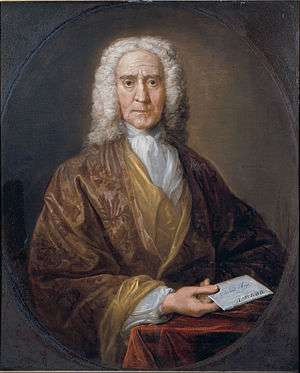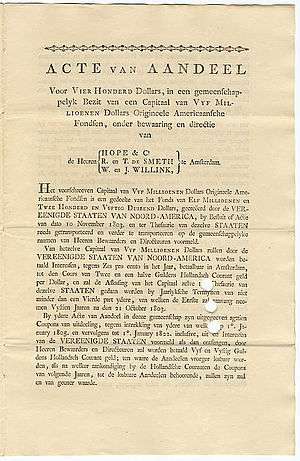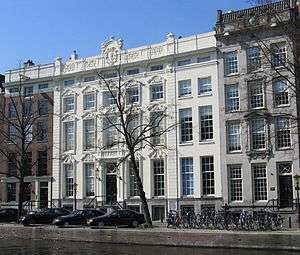Hope & Co.
Hope & Co. is the name of a famous Dutch bank that spanned two and a half centuries. Though the founders were Scotsmen, the bank was located in Amsterdam, and at the close of the 18th century it had offices in London as well.



Early days
Six of eight sons of the Scottish merchant Archibald Hope (1664–1743) – Archibald Jr. (1698–1734), Isaac, Zachary, Henry, Thomas (1704–1779), and Adrian (1709–1781) – were merchants of trade. They were active in shipping, storage, insurance, and credit in Amsterdam and Rotterdam. In 1720 they barely survived the bubble that led to the passage of the Bubble Act in London.[1] Buist was correct about all family members except for his data on the father of Archibald I, called Harry, who was the son of James Hope, factor in Dieppe and brother of Sir Thomas Hope, 1st Baronet. Many bankers in Holland at that time went bankrupt, and many (including Henry) left the country. That this year was an important one for Dutch bankers is shown by the fact that when Rotterdam issued new telephone numbers in the 20th century, Hope & Co. beat Mees & Zn. in snapping up the number ending with 1720.
In this early period the Hope brothers made money organizing shipment for Quakers out of Rotterdam (under the direction of Archibald, Isaac and Zachary) and the slave trade in Amsterdam (under the direction of Thomas and Adrian). The top years for the Quaker transport to Pennsylvania were 1738, 1744, 1753 and 1765. These transports were paid for by the city of Rotterdam and the local Mennonite church, since the Quakers had no money and the city needed to do something about the refugees. In top years the Hopes received 60 guilders per Quaker, and in off years 11 guilders per Quaker. The slave trade was much less lucrative, but the care of the slaves on board the ships was worse. Of these, 16% died on board. During the Seven Years' War (1756–1763) the Hope brothers became very wealthy from speculation.
In 1762 when the nephews Jan (John) and Henry Hope (1736–1811) joined Hopes, the name was changed to Hope & Co. At that time the Englishmen John Williams and Pierre Cesar Labouchere were also partners in the firm totalling 26 people.[1] In that year they expanded the offices in Amsterdam to house Henry and Jan in Keizersgracht 448. Thomas lived in the buildings next door, 444–446. Zachary's son Archibald (1747–1821) became a member of Dutch Parliament, regent of the West Indian Company (WIC), and owned the former palace 'Lange Voorhout' in the Hague.
Pierre's marriage in 1796 to the third daughter of Francis Baring, Dorothy, was the cement between the two firms Barings and Hopes.[1]
Important archive
The Hope archive (1725–1940) is an important source for the history of Amsterdam and the Netherlands as the center of world commerce in the 18th century. In 1977 the archive was given to the Amsterdam City Archives, where it is now open to the public.[2]
The archive of the firm Hope & Co is mixed up with the archive of the Dutch East India Company (VOC) because in 1752 one of the founding Hope brothers, Thomas Hope (1704–1779), became a member of the "Lords XVII", the managers of the VOC. Four years later he became head regent of the VOC, and in 1766 he became the spokesperson for William V of Orange, the formal head of the VOC. In 1770 Thomas retired and passed his responsibilities to his son John (1737–1784), who remained with the VOC and Hope & Co. until his death.[1]
Pierre Labouchere played an important role in negotiations with France, handling most of the financing for Holland with that country. Adrian was a member of Dutch Parliament and the Amsterdam City Council. Unlike banks today, the partners of Hope & Co. mixed up their private business with public business and the bank's business. Letters in the archive touch on many subjects at once. The earliest letters go back to the 1720s and are addressed to Thomas and Adrian Hope. A particularly rich portion of the archive is the correspondence in the period 1795–1815, when Henry Hope was forced to leave the Netherlands and set up offices in London. The regular correspondence between the Amsterdam and London branches give important insights into trade negotiations of the period and how they were done.
The day-to-day running of Hope & Co. in those days was in the hands of Thomas' American nephew Henry Hope (1736–1811), who did business with different countries, including Sweden, Poland, Russia, Portugal, Spain, France and the United States.[1] In 1804 Hope & Co. issued shares to finance the Louisiana Purchase, thanks to the negotiations of Henry Hope and Francis Baring.[3]
Art collection
Though primarily interested in trade deals from the start of their activities, the Hope brothers expanded their interests to longer term investments in land and the arts. During the 18th century Hope & Co. set up a profit sharing agreement for the partners to reduce the risk of bankruptcy of the entire firm due to the indiscretions of one member, as happened in the case of rival banking house Clifford in 1772.[1] In order to become partner in the profit sharing scheme, the member had to learn the special Hope & Co. bookkeeping method developed by Adrian Hope, who had assisted filing the Clifford bankruptcy. According to personal investments, ownership of the art (and the rest of the investment portfolio) was spread evenly. Thus one art collection was jointly owned by several men. John Hope's son Thomas Hope (1769–1831) helped to build this joint collection and later inherited a large portion of it due to the ownership rights built up by his father and grandfather. When it became clear that his own sons would not continue the banking business, after Henry Hope's death he divided his portion finally from the rest. Henry Hope's portion was divided among his sister's family and his American cousins. He died childless in 1811.
Adriaan van der Hoop (1778–1854), who had been active with the firm throughout the French occupation and who became full partner in Hope & Co. in 1814, on the death of Henry Hope inherited the Amsterdam portion of the investments, together with fellow partner in Amsterdam Alexander Baring, who then chose land over art and moved to America. When Adriaan van der Hoop died, he was worth 5 million guilders. His art collection went to the city of Amsterdam that created a museum to house the collection after his death. Among the 250 17th and 18th century works in this collection were 'The Jewish Bride' by Rembrandt, 'Woman in Blue Reading a Letter' by Vermeer, 'Moederzorg' by Pieter de Hooch and 'De molen bij Wijk bij Duurstede' by Jacob van Ruisdael.
Later years
In the 19th century Hope & Co. specialized in railway investments in the United States and Russia. In the 20th century the emphasis shifted from international transport to Dutch investments.
In 1937, Hope & Co. acquired Van Loon & Co., formerly Wed. Borski. In 1966 Hope & Co. merged with R. Mees & Zoonen to form Mees & Hope, Bankiers. In 1969, the Company merged with Nederlandse Overzee Bank. Ultimately, it was bought by ABN Bank in 1975. After the merger of ABN Bank and Amro Bank to form ABN Amro, Bank Mees & Hope merged with Pierson, Heldering & Pierson (then wholly owned by Amro Bank) in November 1992 into MeesPierson and was subsequently sold to Fortis. It subsequently became part of ABN Amro again when Fortis failed and Fortis' Dutch businesses were re-established as ABN Amro.
The Hope family
In many historical documents, this bank is referred to as simply "Hopes" and sometimes "Hopes of Rotterdam" or "Hopes of Amsterdam".
| ? | ? | ||||||||||||||||||||||||||||||||||||||||||||||||||||||||||||||||||||
| Archibald I (1664–1743) | Van der Hoop (cousin) | ||||||||||||||||||||||||||||||||||||||||||||||||||||||||||||||||||||
| Archibald II (1698–1734) | Henry I (1699–1737) | Isaac (1702–1767) | Thomas Hope (1704–1779) | Adrian (1709–1781) | Zachary (1717–1770) | Adriaan (I) van der Hoop (1701–1767) | |||||||||||||||||||||||||||||||||||||||||||||||||||||||||||||||
| Henry Hope (1735–1811) | Olivier (1731-after 1767) | Jan Hope (1737–1784) | Archibald III (1747–1821) | Joan Cornelis van der Hoop (1742–1825) | |||||||||||||||||||||||||||||||||||||||||||||||||||||||||||||||||
| John Williams (Adopted) | Thomas Hope(1769–1831) | Adrian Elias Hope | Henry Philip Hope | Adriaan van der Hoop (1778–1854) | |||||||||||||||||||||||||||||||||||||||||||||||||||||||||||||||||
Canon of Amsterdam
- Hope & Co is window number 22 in the Canon of Amsterdam.
References
- Buist, Marten Gerbertus (1974). At spes non fracta: Hope & Co. 1770-1815. Merchant bankers and diplomats at work. The Hague: Martinus Nijhoff. ISBN 90-247-1629-2.
- "Archive of the company Hope & Co". City archive Amsterdam. Archived from the original on 20 December 2012. Retrieved 18 November 2015.
- "Louisiana Purchase". City archive Amsterdam. Archived from the original on 1 October 2011. Retrieved 18 November 2015.
Further reading
- Buist, M. G. (1974), At spes non fracta: Hope & Co. 1770–1815. Merchant bankers and diplomats at work., The Hague: Martinus Nijhoff, ISBN 90-247-1629-2.
- Jonker, Joost Pieter Bastiaan (1997), The link between past and future: 275 years of tradition and innovation in Dutch banking, Amsterdam: MeesPierson, ISBN 90-901073-0-4.